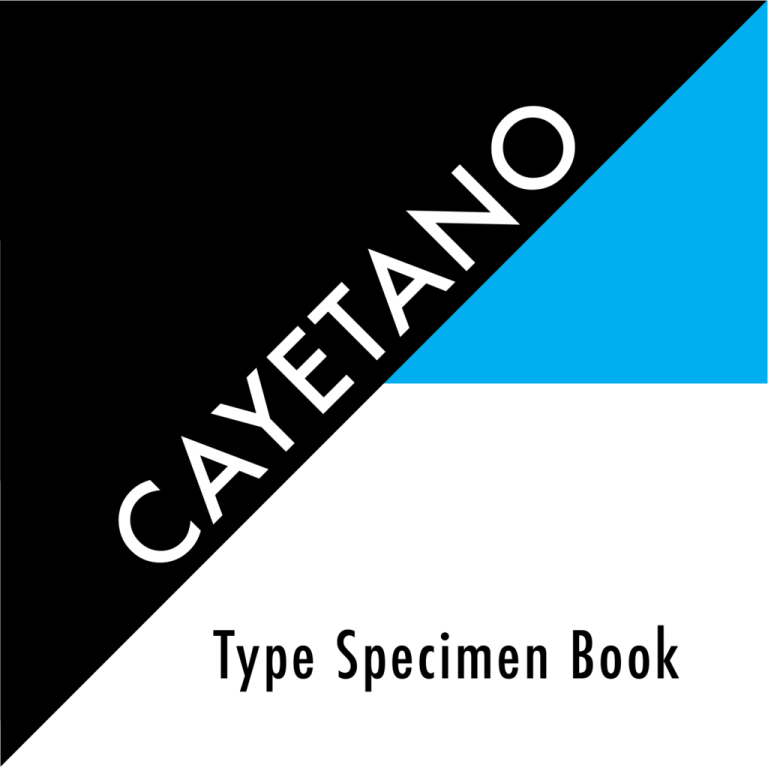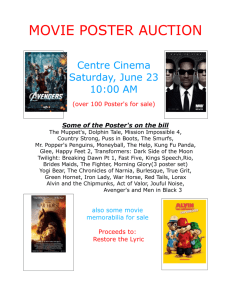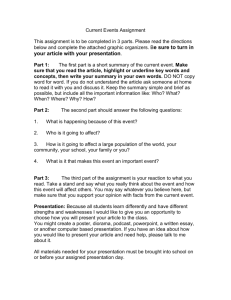
O
N
TA
A
YE
C
Type Specimen Book
Table of Contents
3-4
Type Specimon
5
Common Typigraphic Diseases
6
Ranking for Heigharchy
7
International Fair Poster
All rights reserved. No part of this publication may be republished, systematically
reproduced or transmitted in any form or by any means, including photocopying, recording, or by any information storage or retrieval system, without permission in writing
from Cayetano Press LLC.
8
Rite off-Centre Poster/Postcard Contest
9-10
Type Crimes
Publisher: Cayetano Press, Pasadena, CA
11
Bitmapped Letterforms
12
Letter/Digit Combos
13
Facts at Hand
14
Making Connections 2
Advanced Graphic Design Journal of Documents and Identity—
A Typography Specimen Book
© Spring 2013 Christian Cayetano
Cayetano Press LLC 1137 S Mar Vista St. Pasadena, CA 91103-5618
Production Notes:
This book was designed using Adobe InDesign, Illustrator, and Photoshop and output
to Portable Document Format (PDF). The fonts in the book are Futura and Optima. Sixteen pages at 10” x 10”; illustrations, photos. (PDF output)
Contributors:
The students of the first ever Advanced Graphic Design class of the Visual and Performing Arts
Department of California State University San Marcos
1
2
Type Specimen
Condensed Medium
Condensed ExtraBold
Medium
Medium Italic
Aa Bb Cc Dd Ee Ff Gg Hh Ii Jj Kk Ll Mm Nn
Oo Pp Qq Rr Ss Tt Uu Vv Ww Xx Yy Zz
1 2 3 4 5 6 7 8 9 10
3
Love Affair
Futura
designed in 1927
by Paul Renner
In typography, Futura is a
geometric sans-serif typeface. It was designed as
a contribution on the New
Frankfurt-project. It is based
on geometric shapes that became representative of visual elements of the Bauhaus
design style of 1919–1933.
4
COMMON TYPOGRAPHIC
DISEASES
Various forms of dysfunction appear among populations exposed to typography for
long periods of time. Listed here are a number of frequently observed afflictions.
Typophilia
An excessive attachment
to and fascination with the shape of letters,
often to the exclusion of other interests and
object choices. Typophiliacs usually die penniless and alone.
Typophobia The irrational dislike
of letterforms, often marked by a prefere-nce
for icons, dingbats, and—in fatal cases—bullets and daggers. The fears of the typophobe
can often be quieted (but not cured) by steady
doses of Helvetica and
Times Roman.
Typochondria A persitent anxiety
that one has selected the wrong type-face.
This condition is often paired with okd (optical kerning disorder), the need to constantly
adjust and readjust the spaces between letters.
Typothermia The promiscuous
refusal to make a lifelong commitment to
a single typeface—or even to five or six, as
some doctors recommend. The typothermiac is constantly tempted to test drive “hot”
new fonts, often without a proper license.
5
Ellen Lupton, Thinking with Type, 2nd revised
and expanded edition: A Critical Guide for
Designers, Writers, Editors,
& Students (Design Briefs) (New York, Princeton Press, 2004, 2010)
“Print situates words in space more relentlessly than
writing ever did. Writing moves words from the sound
world to a world of visual space, but print locks words
into position in this space. Control of position is
everything in print. Printed texts look machine-made,
as they are. In handwriting, control of space tends to
be ornamental, ornate, as in calligraphy. Typographic
control typically impresses most by its tidiness and
invisibility: the lines perfectly regular, all justified on
the right side, everything coming out even visually,
and without the aid of guidelines or ruled borders that
often occur in manuscripts. This is an insistent world of
cold, non-human, facts.”
Quote adapted from Walter Ong, Orality and
Literacy: The Technologizing of the Word
(London and New York: Methuen, 1982)
“Nothing is original. Steal from anywhere that resonates with inspiration
or fuels your imagination. Devour old films, new films, music, books,
paintings, photographs, poems, dreams, random conversations, architecture, bridges, street signs, trees, clouds, bodies of water, light and shadows.
Select only things to steal from that speak directly to your soul. If you do
this, your work (and theft) will be authentic.”
-Jim Jarmusch
RANKING FOR
HIERARCHY
Why? When? Where?
All remaining information is subordinate. Unless restricted from doing so, consider adding
information of your own to support or elaborate upon the primary question—why?
This is where research is needed. Both textual
and visual solutions need to be explored to
build a visual statement, a unified whole—
bigger than the sum of its parts.
The existing fan is already sold. The goal of
the poster (commercially) is to grab a potential fan who comes to the event based solely
on the poster.
No job is finished without a few client changes; use the proofing process to your advantage. Go ahead and add supportive text or
remove what you may consider extraneous.
The client may like your words better than
their own.
Establish a hierarchy. Rank groupings into
order of importance—what you wish to be
read first, then second, and so on. Don’t let
the given order of importance influence you
overly. You may wish to emphasize a different order, based on logic or aesthetics of your
own. Copy/paste each line of text into its own
text box so it may be moved around and stylized independently. Ranking now saves
time later.
Create subsets within the rankings. (i.e.
“Organized By,” can be significantly less
emphasized than, “University Global Affairs
Committee.”) Although ranked the same,
the identifier is not as important as the
proper noun, but must remain clustered to
make logical sense.
Subdivide text groupings with line breaks
into smaller units and remove extraneous
punctuation and conjunctions. Simplify text
wherever possible. (you can add these items
back in later, if necessary)
Use only high-resolution photos (0 ppi).
Bear in mind that pixel information can
only scaled so far, but vector information
(text) can be scaled without degradation of
image.
What your client likes and expects plays a
big part in what you choose to emphasize.
Run with whatever creative license comes
your way!
Graphic design is primarily a medium of communication. Graphic designers
balance the aesthetic against the communicative, the innovative against the
expected. Asked to deliver not only the commercial interpretation of image,
but also the accurate edification of word, graphic artists by definition must
remain sensitive to external and internal influences, daring to open their eyes
and really look. But then they must don their armor and thicken their skin
to withstand the criticism and mixed reactions from an audience of varying
tastes.
-James Miller
6
Internaional Fair
Poster
7
Rite off-Centre Poster/
Postcard Contest
8
Type Crimes
Type Crimes
Examples
The Crime:
Vertical or Horizontal
Scaling
Stretching letters distorts their
overall proportions and internal line
weights. This crime is committed
both inadvertently (through careless
use of software) and in cold blood
(in order to force type to fill a given
space).
The Crime:
Pseudo Italics
A true italic typeface is not just a
slanted version of a roman font.
The characters are specially designed to provide a traditional
modeof variation within
a type family.
9
10
Bitmapped Letterforms
11
Letter/Digit Combos
12
13
Facts at Hand
Making Connections
2
14
CAYETANO
Type Specimen Book











